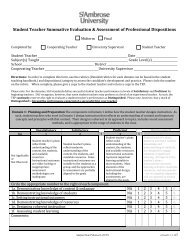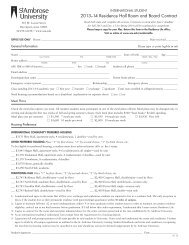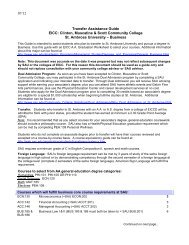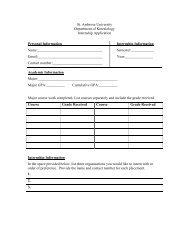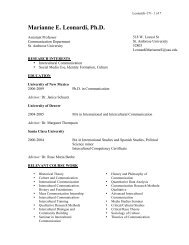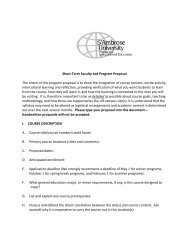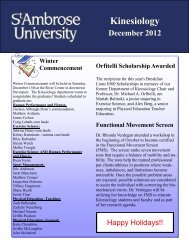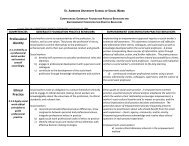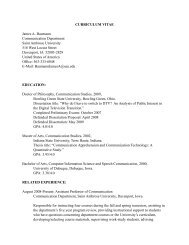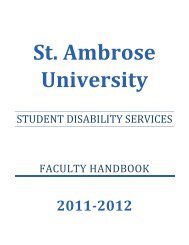St. Ambrose University 518 West Locust Davenport Iowa 52803 admit
St. Ambrose University 518 West Locust Davenport Iowa 52803 admit
St. Ambrose University 518 West Locust Davenport Iowa 52803 admit
Create successful ePaper yourself
Turn your PDF publications into a flip-book with our unique Google optimized e-Paper software.
Undergraduate Programs<br />
hols, ethers, carbonyl compounds and amines.<br />
<strong>St</strong>ructure-reactivity relationships and basic reaction<br />
mechanisms are stressed. Prerequisite:<br />
CHEM 106.<br />
CHEM 208. Organic Chemistry II 3 credits<br />
A continuation of CHEM 207. Topics include<br />
molecular orbital theory of conjugated systems,<br />
electrophilic and nucleophilic aromatic substitution,<br />
free radical and carbanion reactions, the<br />
chemistry of nitrogen-containing compounds and<br />
further work with stereochemistry. <strong>St</strong>rategies for<br />
organic synthesis are introduced and illustrated<br />
throughout the course. Prerequisite: CHEM 207.<br />
CHEM 209. Organic Chemistry<br />
Laboratory I<br />
1 credit<br />
Theory and practice of methods for preparation,<br />
purification and characterization of organic compounds.<br />
Techniques studied include recrystallization,<br />
distillation, extraction, chromatography and<br />
determination of physical properties. Prerequisite<br />
or co-requisite: CHEM 207.<br />
CHEM 210. Organic Chemistry<br />
Laboratory II<br />
1 credit<br />
Continuation of CHEM 209. Emphasizes use of<br />
modern instrumental methods for monitoring<br />
chemical reactions and elucidation of structures<br />
of organic compounds. Practice provided in the<br />
collection and interpretation of data using mass,<br />
ultraviolet visible, infrared and nuclear magnetic<br />
resonance spectrometers. Prerequisite:<br />
CHEM 209.<br />
CHEM 301. Quantitative Inorganic<br />
Analysis<br />
4 credits<br />
<strong>St</strong>udy of the theory of chemical equilibria as it<br />
applies to gravimetric and volumetric analysis.<br />
Laboratory experience with basic quantitative<br />
techniques, including statistical methods of data<br />
analysis, is included. Lectures and laboratory.<br />
Prerequisite: CHEM 106. Offered alternate years.<br />
CHEM 303. Instrumental Analysis 4 credits<br />
Basic theory, operation, and application of techniques<br />
of instrumental chemical analysis. Includes<br />
spectroscopy, chromatography, and electroanalytical<br />
methods. Lectures and laboratory.<br />
Prerequisite: CHEM 210. Offered alternate years.<br />
CHEM 311. Research Methods<br />
in Organic Chemistry<br />
3 credits<br />
By selecting and carrying out several miniresearch<br />
projects, students are introduced to use<br />
of literature searching and laboratory techniques<br />
for solving problems in organic chemistry.<br />
Progress shared at weekly research group meetings.<br />
Lecture and lab. Prerequisite: CHEM 210.<br />
CHEM 313, 314. Physical Chemistry<br />
I and II<br />
4 credits<br />
Principles and applications of theoretical chemistry<br />
including thermodynamics, quantum<br />
mechanics and kinetics. Lecture and laboratory.<br />
Prerequisites: CHEM 106, PHYS 204 or 251,<br />
and MATH 192. Offered alternate years.<br />
CHEM 319. General Biochemistry 4 credits<br />
Application of chemical principles to the study of<br />
living systems. <strong>St</strong>ructure and chemical properties<br />
of biomolecules discussed, followed by analysis<br />
of important metabolic processes within the cell.<br />
The lab provides experience with macromolecular<br />
separation and characterization. Lecture and<br />
lab. Prerequisite: CHEM 207 or instructor permission.<br />
CHEM 321. Advanced Inorganic<br />
Chemistry<br />
4 credits<br />
Advanced topics in inorganic chemistry emphasizing<br />
structure, periodicity, bonding, transition<br />
metal chemistry and reactions. Prerequisites:<br />
CHEM 106, junior or senior standing. Offered<br />
alternate years.<br />
CHEM 333. Environmental Chemistry 4 credits<br />
In-depth study of the environment using chemical<br />
principles. Covers the sources, reactions, transport,<br />
effects and fates of chemical species in<br />
water, soil and air environments. Laboratory provides<br />
experience with environmental sampling<br />
67




